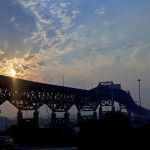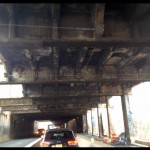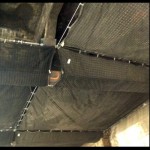Debris Netting on the Pulaski Skyway
 You’re probably familiar with the Pulaski Skyway from the opening of the TV show, The Sopranos. It’s the bridge with the black steel truss girders that Tony Soprano drives over on his way home to his New Jersey mansion.
You’re probably familiar with the Pulaski Skyway from the opening of the TV show, The Sopranos. It’s the bridge with the black steel truss girders that Tony Soprano drives over on his way home to his New Jersey mansion.
Opened in 1932, the Pulaski Skyway is New Jersey’s most famous elevated roadway. It was built in the 1920s as one of America’s first “super-highways,” and is listed on the National Register of Historic Places. The skyway is named for General Casimir Pulaski, a Polish cavalry officer who led American troops in several New Jersey battles during the Revolutionary War.
Unfortunately, time and traffic have taken their toll on the Pulaski Skyway, and the bridge is now in need of major renovation work. In 2012, the New Jersey Department of Transportation began a $1.8 billion, multi-phase rehabilitation, designed to extend the life of the bridge. Recently, FallProof Systems provided a custom debris netting solution to aid in the removal of a section of the skyway’s old roadway.
Renovating the Skyway
The 3.5-mile skyway links Jersey City with South Kearny and Newark. Eastbound, the Pulaski Skyway’s steel truss cantilever bridge carries Routes 1 and 9 over the Hackensack and Passaic Rivers, the New Jersey Turnpike, and various industrial facilities and rail yards. At Tonnelle Circle, Routes 1 and 9 exit into Jersey City, and the skyway continues as Route 139 through the Hoboken Viaduct. The skyway ends at Bergen Hill in Newark, but 139 continues eastbound for several miles, and connects to the Holland Tunnel.
In effect, the NJDOT and its contractors are rebuilding the skyway from the inside out. The skyway gets so much traffic that closing it down entirely during the renovation would not be practical. (Before the renovation, the skyway handled about 74,000 cars per day.) So the construction workers have been tearing out and replacing roadways on alternating lanes on the skyway, while traffic continues on the unaffected lanes.
On Phase 2 of the project – replacing the roadway on the Hoboken Viaduct – the NJDOT faced a problem. The viaduct is a split-level roadway. The elevated upper roadway provides motorists with access to Jersey City streets. The lower roadway – which runs directly underneath the upper roadway, 15 feet below ground level – carries Route 139’s traffic between the skyway’s main bridge and the Holland Tunnel.
The NJDOT needed a way to replace the viaduct’s upper roadway without closing or affecting traffic on the roadway below. If any chunks of concrete fell on the lower roadway while the upper roadway was being demolished, the entire lower roadway might have to be closed for cleanup, or as a traffic safety hazard.
A Custom Bridge Netting Solution
For the Hoboken Viaduct project, FallProof’s engineers designed a custom netting solution. They looked at the original 1927 architectural drawings of the skyway, and took measurements of the viaduct’s various sections from those plans.
 The area to be covered by debris netting under the upper roadway was about a half-mile in length, four lanes of traffic in width, and contained six non-perpendicular intersections where the underlying support structure was at an angle to the rest of the roadway. All the netting would be attached to girders and crossbeams on the viaduct’s underside. Before the project phase began, FallProof’s engineers created detailed drawings showing the size and shape of each net, and where and how the nets would be placed on the viaduct’s understructure. Once these drawings were approved by both the contractor and the NJDOT, the measurements were field verified by construction workers on the viaduct itself.
The area to be covered by debris netting under the upper roadway was about a half-mile in length, four lanes of traffic in width, and contained six non-perpendicular intersections where the underlying support structure was at an angle to the rest of the roadway. All the netting would be attached to girders and crossbeams on the viaduct’s underside. Before the project phase began, FallProof’s engineers created detailed drawings showing the size and shape of each net, and where and how the nets would be placed on the viaduct’s understructure. Once these drawings were approved by both the contractor and the NJDOT, the measurements were field verified by construction workers on the viaduct itself.
On bridge renovation projects, FallProof uses Roc-Bloc, a special kind of nylon netting that is strong enough to catch and hold large chunks of concrete. A fine-mesh debris liner is placed inside this nylon net to catch small pieces of debris – such as bolts, nails, screws, or tiny chunks of concrete and plaster – that might fall through the spaces between the weave of the netting underneath it.
Challenges and Logistics
The custom solution for the Hoboken Viaduct had to overcome several challenges. First, since the workers on the upper roadway would only be demolishing one lane at a time, the debris netting under the viaduct had to be installed in sections under each lane.
 FallProof’s engineers designed custom brackets to hold the netting in each section under the viaduct. These brackets were fabricated by FallProof and then installed by the contractor into the girders and crossbeams under each lane. In places where brackets couldn’t be installed, FallProof’s engineering designs called for the installation team to wrap cable around the supporting structures, or use concrete anchors that were epoxied into the understructure. The cable and concrete anchors were then used to hold the netting.
FallProof’s engineers designed custom brackets to hold the netting in each section under the viaduct. These brackets were fabricated by FallProof and then installed by the contractor into the girders and crossbeams under each lane. In places where brackets couldn’t be installed, FallProof’s engineering designs called for the installation team to wrap cable around the supporting structures, or use concrete anchors that were epoxied into the understructure. The cable and concrete anchors were then used to hold the netting.
Some areas under the viaduct required debris netting in custom shapes (in squares, triangles, trapezoids, etc.). FallProof’s engineers worked with the netting manufacturer to create special-shaped netting sections to fit these areas. Each net was labeled by the manufacturer to show the specific location where it would be installed, and shipments were made one lane at a time to facilitate the installation.
Also, with only two inches of clearance under the viaduct’s understructure, the netting could easily be ripped away by a tall semi-truck passing by on the road underneath it. Therefore, the debris netting had to be flushed, or stretched, very tight between brackets so it wouldn’t hang down. In the case of crossbeams, the netting had to dip underneath the beam and be pulled tight against it while attached to brackets of adjacent netting sections.
Night Work
The nets had to be installed under the viaduct at night, during periods of lowest traffic. One or two lanes were closed off on the lower roadway per night, so the contractor could install the netting sections.
Once the debris nets were installed, the road construction workers began demolishing the upper roadway on the viaduct, one lane at a time. The nets full of debris were removed as each section of the roadway was demolished. The road construction workers then removed the old steel crossbeam structure of the viaduct, and rebuilt it with a new steel beam structure. A new roadway will be paved over this new beam structure.
The entire renovation of the Pulaski Skyway and the Hoboken Viaduct is expected to be completed by 2020.

